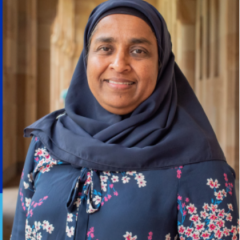Written by Chris Clarke
It's a simple concept – Indigenous communities use their knowledge of the land to harvest, process and commercialisenative foods each year. Yet, despite this, only about 13 of the 6500 native fruits in Australia have made their way into food regulation.
It is a missed opportunity that Professor Yasmina Sultanbawa plans to change – not just in Australia but around the world – with these foods boasting a range of extraordinary flavours, versatility and health benefits.
Professor Sultanbawa first fell in love with the tastes of Australia in 2007 after she was introduced to the Kakadu plum.
"I came across the Kakadu plum through a research project funded by Agri Futures that introduced me to an Indigenous community in the Northern Territory," she said.
"When I called the community they were having a cyclone.
"You need to be invited into these communities and build a partnership and you become a facilitator and the community leads the research. I ended up going there for 4 or 5 Easters, around the time when the Kakadu plum was being harvested each year.
"In that moment everything came together. There was so much excitement because they wanted to do something with their land and earn an income."
That's when everything changed. Using her expertise in food science, Professor Sultanbawa co-designed a business model for the community that allowed them to profit from their own native fruit.

Community members would bring kilograms of Kakadu plums to the processing facility in exchange for money, while Professor Sultanbawa's research helped promote the benefits of the fruit. After 3 or 4 years, she began to see the Kakadu plum appear in multiple food and cosmetic products Australia-wide, and partnerships develop with the Indigenous community.
A collaboration with the Department of Agriculture and Fisheries in Queensland and the Australian Seafood CRC resulted in the use of Kakadu plum in the preservation of fresh cooked chilled prawns. Using the Kakadu plum with high antioxidant capacity retained the freshness in the prawns.
She believes the untapped native food market globally has the potential to revolutionise how we cook and preserve food, but also empower First Nations People to profit from their unique skills and understanding of their lands.
"We’ve just kept growing," she said.
"More communities have come on board now and I have trained and continue to train over 20 PhD students. They're not just Aussies, but students from overseas and they have gone back home, and they are looking at all the local underutilized crops they can work with.
"It feels like a movement now."

Part of that movement has seen Professor Sultanbawa and her students team with several other Indigenous communities all over Australia to maximise the potential of their native fruit. The preservative properties of the Kakadu plum have also been used to prolong the shelf life of beef by several more days, along with frozen meals by up to 12 months.
Meanwhile, reduced sugar beverages have also been created that use a Kakadu plum base with Davidson plum, offering a unique flavour without the negative health outcomes. Professor Sultanbawa said the same concept is possible for other sugar-reliant foods such as ice cream, where First Nations People can use a native fruit from their region to develop the product to their tastes.
"We have reduced the sugar by around 80 percent in the Kakadu plum beverage" she said.
"The Kakadu plum is the base, but each community can adapt it to what they want. For example, if it’s north Queensland they can use the Davidson plum. If it’s Northern Territory they can use the green plum. In Alice Springs, there’s a native peach that they can use.
"The people can own it and brand it, but the base is Kakadu plum. We can do a similar thing for ice creams. We can use a whole range of native flavours while reducing the sugar and adding a native ingredient."
Professor Sultanbawa now hopes to turn her UQ training facility Uniquely Australian Foods – which has been instrumental in growing the understanding of Australia's native food culture more broadly – can be turned into an Australian Research Council Centre of Excellence.
Part of that goal includes an idea to promote the culinary success of these communities on a world stage at the 2032 Brisbane Olympics.
"In 2032, we should be showcasing these flavours," Professor Sultanbawa said.
"I would brand different regions with different foods. For example, 1 of our communities in the Lockyer Valley is developing an ice cream with different native flavours from a milk produced in that region. So could we tell the story of Lockyer Valley and brand it with this image and food?
"Could we tell a different story for Cairns, or Southeast Queensland. Imagine the variety and knowledge we could share with all the narratives we could tell with these foods and their history.
"It’s a fusion of cultures. It’s a coming together of cultures and the star would be the native foods."



